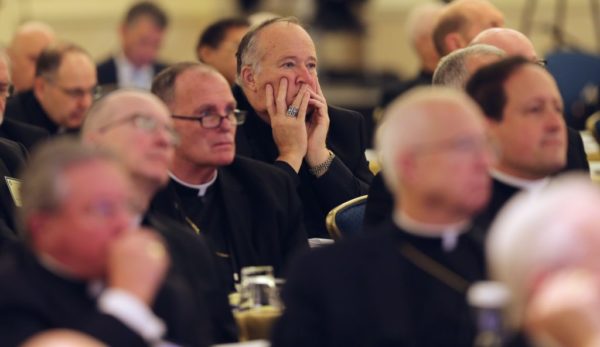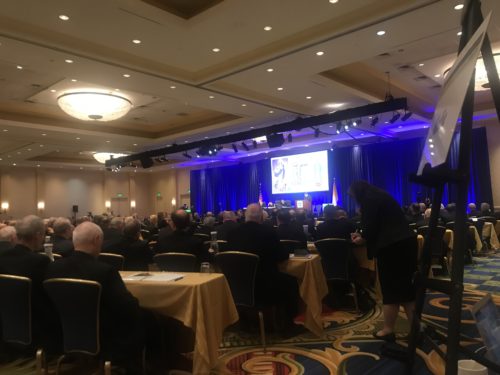By Christopher White, The Tablet’s National Correspondent

NEW YORK – Addressing the United States Conference of Catholic Bishops (USCCB) at the closely watched meeting in June 2002, as the first wave of clergy sexual abuse crisis in the U.S. reached its zenith, then-president Bishop Wilton Gregory promoted new measures of reform and accountability “in a way that ensures it will not happen again.”
Now, beginning on Monday, the U.S. bishops once again will meet to confront the painful reality that while its policies and procedures may have broken new ground, its Charter for the Protection of Children and Young People has failed to hold bishops accountable for abuse and its cover-up.
Following this summer’s wave of sexual abuse revelations – from a Pennsylvania grand jury report that chronicled seven decades of abuse of more than 1,000 victims at the hands of 300 predator priests, which has sparked over a dozen other states to launch similar reviews, to the downfall of former Cardinal Theodore McCarrick who sexually abused seminarians for decades – many Church leaders have conceded that the current crisis is the greatest test the American Catholic Church has faced in its history.
As leaders from the country’s 195 Catholic dioceses meet in Baltimore next week, there are high-stakes expectations that the U.S. bishops will enact new measures to hold bishops accountable and take new steps to restore the trust of the nation’s nearly 75 million Catholics.
Zero Tolerance: Take Two
While the U.S. bishops hold bi-annual meetings each June and November to conduct conference-wide business, the current crisis prompted Pope Francis to suggest to the USCCB leadership that they scrap the formal agenda, and instead hold a weeklong spiritual retreat.
The pope put forward his proposal at a Vatican meeting in September with USCCB president Cardinal Daniel DiNardo; vice-president Archbishop Jose Gomez; head of the pope’s Commission for Protection of Minors, Cardinal Sean O’Malley; and secretary-general of the USCCB, Monsignor Brian Bransfield.
Multiple sources have told The Tablet that given the tight timeline, conference leadership viewed the proposal as untenable and decided to move ahead with the meeting, but also, as they announced last month, they will hold a weeklong retreat at the beginning of January led by preacher to the papal household, Capuchin Father Raniero Cantalamessa.
As a teaser, on Monday the meeting will begin with the traditional address from the president of the conference followed by remarks from the pope’s representative to the United States, French Archbishop Christophe Pierre.

Afterwards, the bishops will transition into a spiritual retreat at the on-site chapel followed by an evening Mass.
Tuesday and Wednesday are likely to be dominated by discussions on sex abuse reform, as the bishops seek to formulate their response to the current crisis. At stake are four primary areas of concern:
- New protocols for bishops removed for abuse.
- A standard of conduct for bishops.
- A third-party reporting mechanism.
- Potential investigations into the McCarrick saga.
While many are seeking a revision to the Dallas Charter – hoping to extend the “zero tolerance” policy against priests to include bishops – that would require more than just a move from the U.S. bishops, but also Vatican authorization.
Under the Code of Canon Law, the only person able to remove a bishop from office is the pope himself, so any pledge of “zero tolerance” that seeks to expedite or modify the process in which bishops can be removed must go to Rome for approval.
Also receiving close attention will be how the bishops seek to move forward on getting answers to the rise and fall of McCarrick. In the aftermath of revelations that the former archbishop of Washington serially abused seminarians for decades, and, in at least one case is accused of abusing a minor, Catholics throughout the country have demanded answers as to how he was able to ascend the ranks of power within the Church hierarchy under such circumstances.
While Cardinal DiNardo publicly announced in August that he would request a Vatican-led investigation into the matter, Francis denied that request in September.
As The Tablet has previously reported, the investigation is likely to move forward in the four dioceses in which McCarrick served. There has also been some discussion as to a Vatican assessore that could help coordinate an investigation, however no appointment has been made to date.
The Tablet has also learned that among the U.S. bishops, there has been considerable discussion about a public statement or show of support for Pope Francis following the release of an 11-page testimonial in August from Archbishop Carlo Maria Viganò, the pope’s former representative to the United States, in which he accused the pope of being aware of McCarrick’s history of misconduct and called for the pope’s resignation.
While Archbishop Viganò’s first letter – along with two-follow-ups – has sparked much controversy, his account has been heavily scrutinized and challenged by Vatican officials. In the immediate aftermath, more than a dozen U.S. bishops expressed their support for Viganò.
While bishops’ conferences in Europe, South America, and Asia have expressed their support for Francis, there has yet to be such an affirmation from the U.S. bishops – a fact that some U.S. bishops are seeking to remedy.
Racism, Elections, and a Report on the Synod
While sex abuse is expected to dominant the agenda of the meeting, the bishops will also hold elections on several key committee posts.
At a time when the U.S. bishops find themselves at odds with President Donald Trump on immigration, the bishops will decide between Colombian-born Auxilary Bishop Mario Dorsonville of Washington and Bishop John Stowe of Lexington, Kentucky to take over the Committee on Migration.
Bishop James Checchio of Metuchen, New Jersey and Bishop Michael Olson of Fort Worth, Texas will be on the ballot for the Committee on Clergy, Consecrated Life, and Vocations – a consequential committee given Francis’s challenges for an end to clericalism and a reform of priestly formation.
Both Bishop Checchio and Bishop Olson have recently been in the national spotlight of the U.S. Church, as Checchio, the former head of the North American College, is seeking to repair the scandal-ridden diocese of Metuchen where McCarrick first began his ecclesial career. Bishop Olson, meanwhile, is fresh off the heels of playing host to the V Encuentro, which took place in his diocese in September, bringing together over 3,000 Hispanic Catholics for a major summit on the future of the U.S. Church.
Other committee posts up for new chairs are the Committee on Catholic Education, Divine Worship, Laity, Marriage, Family Life, and Youth, and Domestic Justice and Human Development. The bishops will also vote on a new treasurer for the conference.
All elected officials will assume their posts in November 2019.
The bishops will also take a vote on the new pastoral letter on racism, which will serve as an update to the 1979 letter “Brothers and Sisters to Us.”
In an interview with The Tablet in February, Bishop George Murry, former head of the newly formed Ad-Hoc Committee Against Racism, told The Tablet the new pastoral letter will be brief, readable, accessible, and will discuss “not only individual attitudes of racism…(but also) some of the broader systemic problems that we often don’t think about as being oppressive to people of color.”
Also on the agenda is an update from last month’s Synod of Bishops on “Young People, Faith, and Vocational Discernment” in Rome, where six U.S. bishops participated in the global gathering.
The outcome document – which has yet to be released in English – offers a pledge against clerical sex abuse, calls for greater involvement of women in the Church, and greater engagement with digital media. It has yet to be determined if Pope Francis will release a follow-up Apostolic Exhortation reflecting on the themes from the synod.
Although it’s not part of the formal agenda, it’s also reasonable to expect the bishops will want to reflect on Tuesday’s midterm elections and what the prospect of divided government may mean for their social agenda over the next two years.
